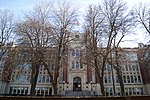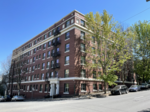Knickerbocker (Spokane, Washington)
Beaux-Arts architecture in Washington (state)Buildings and structures completed in 1911Buildings and structures in Spokane, WashingtonNational Register of Historic Places in Spokane, WashingtonResidential buildings on the National Register of Historic Places in Washington (state) ... and 2 more
Washington (state) Registered Historic Place stubsWikipedia page with obscure subdivision

Knickerbocker is a historic Beaux Arts building in the Cliff/Cannon neighborhood of Spokane, Washington. It was designed by architect Albert Held and was built in 1911. It was listed on the National Register of Historic Places in 1987. The building is also listed on the Spokane Register of Historic Places, under the name Knickerbocker Apartments.
Excerpt from the Wikipedia article Knickerbocker (Spokane, Washington) (License: CC BY-SA 3.0, Authors, Images).Knickerbocker (Spokane, Washington)
South Stevens Street, Spokane
Geographical coordinates (GPS) Address Website Nearby Places Show on map
Geographical coordinates (GPS)
| Latitude | Longitude |
|---|---|
| N 47.651388888889 ° | E -117.41944444444 ° |
Address
Lewis and Clark High School
South Stevens Street
99201 Spokane
Washington, United States
Open on Google Maps










